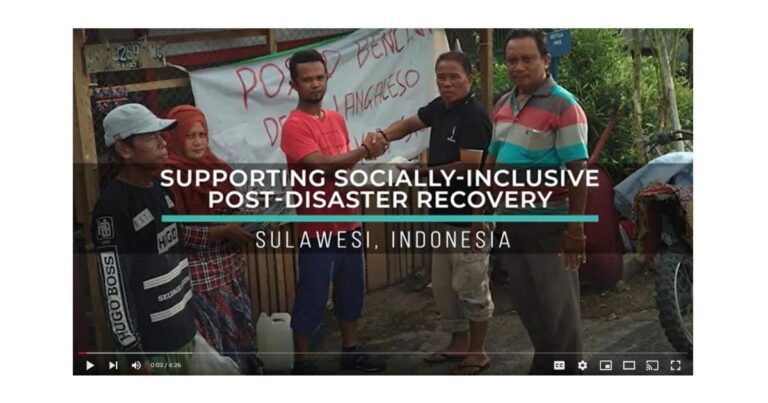This year’s International Women’s Day recognizes the contribution of women and girls around the world who are leading efforts on climate adaptation and strengthening resilience to build a more sustainable future for all.
Natural hazards and climate change tend to affect vulnerable groups disproportionately, particularly women and girls. Yet they are often underrepresented in decision‑making processes – women typically represent only a third of community representatives in village-level disaster risk reduction forums in Indonesia. In addition, persistent discriminatory norms, cultural values, and hierarchies may exacerbate inequalities for women and girls and heighten risks—such as gender-based violence (GBV)—in post‑disaster contexts.
For example, once construction in post-disaster recovery programs start, disaster-affected areas often experience an influx of labor, which is the rapid migration to—and settlement of workers in—these areas. When that happens, GBV risk is heightened, particularly as workers are likely to be in and around already vulnerable communities, increasing the likelihood for escalating social tensions. This results from unequal social conditions between disaster-affected communities and newly arrived workers, reduced privacy of women and girls in temporary settlements, and changing social dynamics.
Astriana Harjanti from Indonesia’s Ministry of Public Works and Housing (MPWH) is one of many leaders addressing the unique needs of women and girls in post‑disaster contexts – a key priority for the government. A key lesson learned has been that social issues are core issues. Speaking at a recent online event hosted by the Global Facility for Disaster Reduction and Recovery (GFDRR), she explained how the Ministry has been leading the way in gender inclusion.
“Collaboration among stakeholders including with the central and subnational levels, and with local women’s representative groups and GBV service providers during the project life cycle is key in delivering universal access design and taking GBV mitigation action … everyone is responsible.” – Astriana Harjanti, MPWH
Below are six good practices that the MPWH has adopted in Central Sulawesi with support from GFDRR.
- Incorporate gender-inclusive planning and GBV risk mitigation at the outset. Key indicators of the project include: (i) women that are aware of land or property title rights; (ii) women that are aware of employment opportunities related to recovery activities; (iii) women participating in decision-making process meetings; and (iv) gender- and disability-inclusive reconstructed public facilities. Community facilitators in Central Sulawesi were mobilized to implement the related initiatives. Raising women’s awareness of property and land rights can help empower them.
- Ensure GBV risk forms a core part of the preliminary risk analysis during project preparation. The Environmental and Social Management Framework (ESMF) for the World Bank’s Central Sulawesi Rehabilitation and Reconstruction Project (CSRRP) provides a set of guiding principles that include GBV risk management. These include ensuring the safety and well-being of GBV survivors in post-disaster contexts, respecting the confidentiality of complainants and survivors, and respecting the survivor’s choices and needs.
- Identify champions and build awareness among all project stakeholders. Successful implementation of policies is dependent on increased awareness and understanding of gender issues. CSRRP has a dedicated gender focal point in MPWH and a full-time GBV specialist. Technical training and stakeholder workshops have helped to champion gender inclusion and enhance project results. For example, early engagement of local women’s groups helped to improve the safety of permanent housing units through additional privacy walls and enhance the design of housing settlements with street lighting design.

- Develop practical tools for project engineers and designers to apply universal accessibility to all reconstructed and rehabilitated infrastructure. In Central Sulawesi, these included design workshops with women and disability interest groups; development of project-specific universal design guidelines, audit checklists, and short videos; and technical training with project consultants.

- Establish project-level reporting mechanisms, codes of conduct, and good contract management practices. A project-specific GBV case reporting mechanism that is accessible, confidential, and centered on survivors with safe reporting channels can help reduce GBV risks and raise awareness. Project workers should sign codes of conduct, and specific clauses incorporated in construction and employment contracts, to prohibit workers from engaging in activities that may lead to increased GBV risks. Contractors should allow for provisions in construction budgets and schedules for periodic GBV risk mitigation awareness raising and incident management.
- Build collaboration with local service providers and partners. Local partnerships are crucial, whether with local NGOs, government agencies, public health services, or other service providers that have good knowledge of the local context and preferably experience with handling GBV cases during and in the aftermath of disasters.
Indonesia has shown how it has improved its commitments over the years in protecting women and children in post-disaster contexts. Continued vigilance and proactive problem-solving are needed to adapt to dynamic post-disaster contexts and mitigate risks.
In this spirit, the World Bank stands ready to continue supporting Indonesia’s endeavors to improve women and girls’ quality of life and strengthen their contribution to the country’s long-term growth.
Related:

